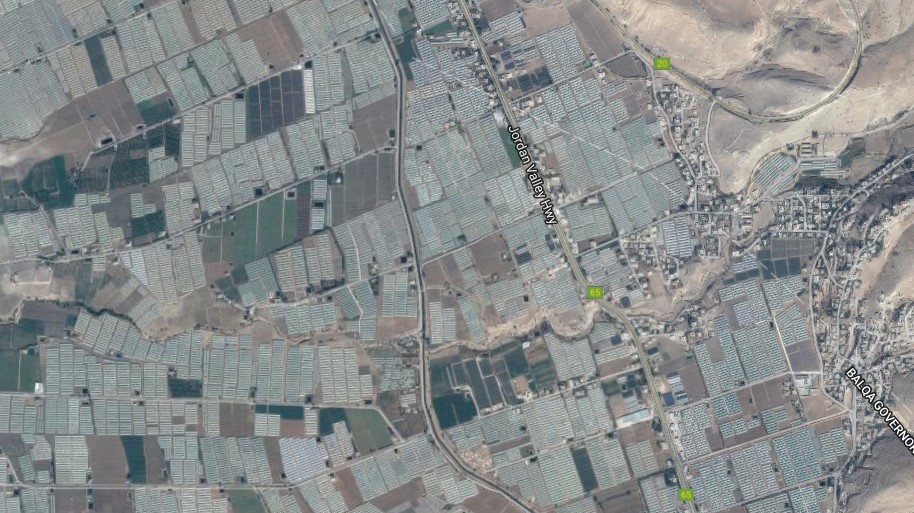
clearly visible.
Jordan is one of the most water scarce countries in the world. High population growth, groundwater depletion in excess of recharge, and climate change all threaten to upset the precarious balance between demand and supply. The road from Ajloun down to the Jordan River twists and turns through 1,200 metres of elevation loss, the last 300 metres well below sea level. The observant traveller can learn a great deal about the many and difficult water management challenges facing Jordanians from this geographical transect, from the forested highlands to the oddly dry but agriculturally productive valley floor.
Ajloun, with its famous Saracen castle built by Saladin in the 12th century to protect his lands from European Crusaders, guards the upper end of a large and agriculturally productive wadi (valley). When not farmed (mostly for olives, citrus and grapes), the wadi’s steep hills are forested with varieties of pine and oak well-accustomed to cold winters that can include long periods of snow and significant rains – up to 500 mm/year.
By contrast, the Jordan River Valley receives less than 300 mm/year but still supplies Jordan with most of its vegetables, with some excess for export. From space, the densely packed poly tunnels of the Valley are easily visible (Figure 1). Al-Ghor is also famous for its high-quality citrus fruits, bananas, melons, cucumbers, tomatoes, leafy vegetables and aubergines. More recently there has been considerable growth in fish farming, particularly tilapia.
Water is the linchpin of this truly hydrosocial system – water managers’ ability to slake the thirst of growing communities, agricultural enterprises, industry, and more recently, the natural environment is tested here as nearly nowhere else on earth.
Not far down route 20 from Aljoun, the Kufranjah Dam is nearing completion of the reservoir filling phase. Jordan’s 12th largest dam structure, the impounded reservoir will eventually hold up to 7.8 million cubic metres (MCM) of water to support agriculture in the area. But whilst useful, water impounded here cannot travel further down the wadi or eventually reach the Jordan River Valley, a zone of both intensive water use (through polytunnel-based agriculture) and worsening desiccation, as volumes travelling down the main stem of the Jordan, and its tributaries, continues to decline.
Key to the agriculture and fish farming of the Jordan River Valley is the King Abdullah Canal (KAC), fed primarily from the Yarmouk River in the far northwest of Jordan, as well as the Zarqa River and the 6–10 small rivers, called ‘side wadis’, going from the mountains in Jordan to the Jordan Valley. The wadi below Ajloun is one of these side wadis.
In an historically dry country, now experiencing the triple threat of population growth, climate change and continued political instability (making water allocation amongst riparian nations a very political subject), large hydro-engineering projects have long been a key element of water security. Six large dams have already been constructed in the north and middle Jordan valley with a total storage capacity of 160 MCM. These dams include the Arab, Ziglab, King Talal (which feeds the KAC from the hydropolitically sensitive Yarmouk River), Karameh, Shueib, Kafrein and now the Kufranjah.
And yet all of these feats of hydro-engineering have not in any sense permanently solved Jordan’s chronic water shortages. There are many reasons for this. First, it is an axiom of economic development that needs satisfied generate new needs, with the result that water engineers are forever playing catch-up. Second, climate change means that annual natural water deliveries are increasingly volatile; some years sufficient, other years not. Third, instability in Iraq and Syria has meant that more than a million people displaced from those conflict-torn countries are now living in Jordan, placing additional demands on an already stretched system. Fourth, and related, is the challenge of achieving political agreement amongst sometimes antagonistic riparian nations – though water can sometimes help mediate conflicts, as well as exacerbate them.
Though Jordanian authorities are still building dams and large schemes, they have also discovered waste water use, currently only for non-potable (agricultural and groundwater recharge) purposes. The reservoir of King Talal Dam (the largest in Jordan) now stores a mix of freshwater from the Zarqa river and treated wastewater from the Amman-Zarqa area, most which is destined for irrigation use in the Jordan Valley. Other wastewater reuse schemes are under consideration. At the same time, Israel and Jordan are cooperating on a version of the long-talked about Red Sea to Dead Sea Water Scheme, which would involve the desalination of Red Sea waters drawn from intakes at Aqaba with resultant brine being used to top up the shrinking Dead Sea (already hypersaline, so perhaps addition of brine may be less impactful). Currently the scheme is facing significant environmental challenges, linked to suggestions that it might impact negatively on both the intake and outlet ends of the planned system.
The story of Ajloun and its wadi provides a good vantage point from which to see the complex water security challenges facing Jordan and its neighbours.
